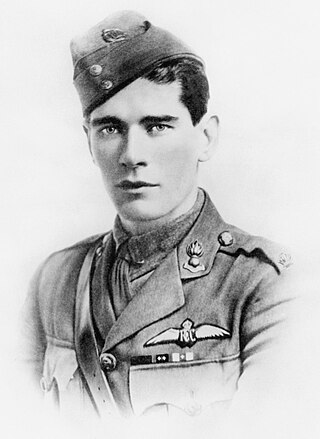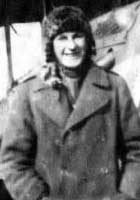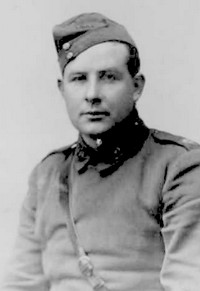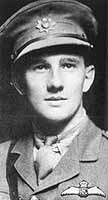Related Research Articles

Edward Corringham "Mick" Mannock was a British-Irish flying ace who served in the Royal Flying Corps and Royal Air Force during the First World War. Mannock was a pioneer of fighter aircraft tactics in aerial warfare. At the time of his death he had amassed 61 aerial victories, making him the fifth highest scoring pilot of the war. Mannock was among the most decorated men in the British Armed Forces. He was honoured with the Military Cross twice, was one of the rare three-time recipients of the Distinguished Service Order, and was posthumously awarded the Victoria Cross.

Captain George Edward Henry McElroy MC & Two Bars, DFC & Bar was a leading Irish fighter pilot of the Royal Flying Corps and Royal Air Force during World War I. He was credited with 47 aerial victories.
Thomas Falcon Hazell & Bar was a fighter pilot with the Royal Flying Corps, and later, the Royal Air Force during the First World War. Hazell scored 43 victories in 1917–18 making him the fifth most successful British "flying ace" of the war, and the third most successful Irish-born pilot, behind Edward Mannock and George McElroy, as well the only pilot to survive the war from both groups.
Captain Keith Knox Muspratt was an English First World War flying ace in the Royal Flying Corps with eight victories to his name.
Flight Lieutenant James Anderson Slater was a British First World War flying ace, credited with 24 aerial victories. He served in the Royal Air Force (RAF) as an instructor after the war until killed in a flying accident.
Benjamin Roxburgh-Smith (1884–1951) was a British World War I fighter ace credited with 22 aerial victories. After the war, he pioneered aviation in southern Africa. He also served in World War II.

Wing Commander William Mayes Fry was a World War I Royal Flying Corps and Royal Air Force fighter ace. He was credited with eleven aerial victories, piloting no fewer than four different types of fighter aircraft. Fry also has the distinction of being one of the few World War I airmen to survive to the 1990s.
Flight Lieutenant William Geoffrey Meggitt was a British World War I flying ace credited with six aerial victories.
Frederick James Powell, was a British flying ace of the First World War, credited with six confirmed and nine unconfirmed aerial victories. He remained in the Royal Air Force post-war, serving until 1927, then returned to military service during the Second World War.
Lieutenant Henry Eric Dolan was a World War I flying ace credited with seven aerial victories.
Captain Thomas Frederick Le Mesurier DSC & Two Bars was a British flying ace of the First World War credited with seven aerial victories. Le Mesurier was awarded the Distinguished Service Cross (DSC) and Two Bars for his conspicuous service in bombing operations.
Flight Lieutenant Forde Leathley was an Irish First World War flying ace credited with eight aerial victories.
Lieutenant Colonel Alan Machin Wilkinson was a British First World War flying ace credited with nineteen aerial victories. He was one of only about 25 pilots twice awarded the DSO during the war, five of whom were also holders of the Victoria Cross.
Captain George Everard Gibbons was a British World War I flying ace credited with 18 aerial victories gained while flying a Bristol F.2 Fighter in 1918. Both of his observers, Sidney Knights and Thomas Elliott, also became aces flying with him. Gibbons' final tally consisted of three enemy aircraft destroyed by fire, five others destroyed, and ten driven down out of control.
Wing Commander Cyril Marconi Crowe was a World War I flying ace credited with 15 victories.

Captain Andrew Cameron Kiddie was a World War I flying ace credited with 15 aerial victories.

Flight Lieutenant Robert Leslie Chidlaw-Roberts was a British World War I flying ace credited with ten aerial victories. During his aerial combat career, and in different dogfights, he engaged two famous German aces; he was one of the British pilots who downed Werner Voss, and on 9 January 1918, he shot down and killed Max Ritter von Müller.
Captain Thomas Laurence Purdom was a Scottish World War I flying ace credited with 13 confirmed aerial victories.
Wing Commander Gwilym Hugh Lewis was a British flying ace during World War I. He was credited with 12 confirmed aerial victories. He went on to a very successful career as an insurance broker. Lewis was the next to last surviving British ace from the war, as well as the longest lived, dying eight months before his hundredth birthday. His wide range of friends included Prime Minister Winston Churchill, playwright Noël Coward, and fellow aces Stan Dallas, Mick Mannock, and George McElroy.
Major Thomas Francis Netterville Gerrard was a British World War I flying ace credited with ten aerial victories. He died following a post-war equestrian accident.
References
- Shores, Christopher F.; Franks, Norman & Guest, Russell F. (1990). Above the Trenches: a Complete Record of the Fighter Aces and Units of the British Empire Air Forces 1915–1920. London, UK: Grub Street. ISBN 978-0-948817-19-9.